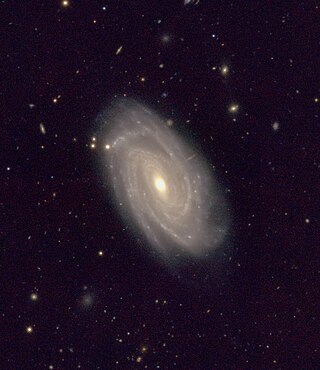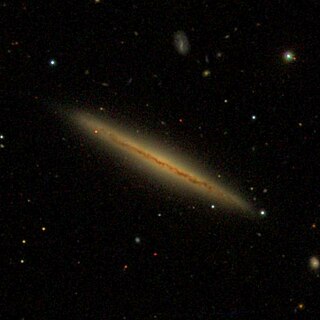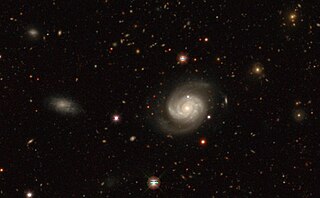
NGC 5821 is a spiral galaxy with a ring structure in the constellation Boötes. It lies near a similarly massed galaxy, NGC 5820, at the same redshift. Both galaxies were discovered by the astronomer William Herschel.

NGC 10 is a spiral galaxy located in the southern constellation of Sculptor. It was discovered by John Herschel on 25 September 1834. The galaxy is located at a distance of 346 Mly from the Sun. Its morphological classification in the De Vaucouleurs system is SAB(rs)bc, where the 'SAB' denotes a weak-barred spiral, '(rs)' indicates a slight ring-like structure, and 'bc' means the spiral arms are moderately to loosely wound. Paturel et al. (2003) assigned this galaxy a classification of SBbc, indicating a barred spiral galaxy.

NGC 12 is an intermediate spiral galaxy in the Pisces constellation. It was discovered by William Herschel on December 6, 1790.

NGC 38 is a spiral galaxy in the constellation Pisces. It was discovered on 30 September 1867 by Édouard Stephan.

NGC 4780 is an intermediate spiral galaxy within the constellation Virgo. It is located about 166 million light-years away from the Sun. It was discovered in 1880 by the astronomer Wilhelm Tempel.

NGC 1728 is a spiral galaxy in the constellation Eridanus. The galaxy is listed in the New General Catalogue. It was discovered on November 10, 1885 by the astronomer Edward Emerson Barnard.

NGC 4634 is an edge-on barred spiral galaxy located about 70 million light-years away in the constellation of Coma Berenices. NGC 4634 was discovered by astronomer William Herschel on January 14, 1787. It is interacting with the spiral galaxy NGC 4633. Both galaxies are members of the Virgo Cluster.

NGC 1288 is an intermediate barred spiral galaxy located about 196 million light years away in the constellation Fornax. In the nineteenth century, English astronomer John Herschel described it as "very faint, large, round, very gradually little brighter middle." The morphological classification of SABc(rs) indicates weak bar structure across the nucleus (SAB), an incomplete inner ring orbiting outside the bar (rs), and the multiple spiral arms are moderately wound (c). The spiral arms branch at intervals of 120° at a radius of 30″ from the nucleus. The galaxy is most likely surrounded by a dark matter halo, giving it a mass-to-light ratio of 14 M☉/L☉.

NGC 3359 is a barred spiral galaxy located 59 million light-years from Earth, in the constellation of Ursa Major. It was discovered on November 28, 1793, by the astronomer William Herschel. The central bar is approximately 500 million years old.

NGC 3059 is a barred spiral galaxy. It is located in the constellation of Carina. The galaxy can be described as being faint, large, and irregularly round. It was discovered on February 22, 1835, by John Herschel. The galaxy has been calculated to be 45 - 50 million lightyears from Earth.

NGC 115 is a barred spiral galaxy located in the southern constellation of Sculptor. It was discovered by the British astronomer John Herschel on September 25, 1834. The galaxy is approximately 85 million light-years from the Sun, and is about 50,000 light-years in diameter, nearly half the size of our home galaxy, the Milky Way.

NGC 178 is a Magellanic spiral galaxy in the constellation of Cetus. The compiler of the New General Catalogue, John Louis Emil Dreyer noted that NGC 178 was "faint, small, much extended 0°, brighter middle". It was discovered on November 3, 1885, by Ormond Stone.

NGC 5470 is an edge-on spiral galaxy located between 43 and 68 million light-years away in the constellation Virgo. It was discovered by astronomer John Herschel in 1830. It is a member of the Virgo III Groups, a series of galaxies and galaxy clusters strung out to the east of the Virgo Supercluster of galaxies.

NGC 5559 is a barred spiral galaxy, located 240 million light-years away in the constellation of Boötes. It was discovered on April 10, 1785, by the astronomer William Herschel.

NGC 479 is a spiral galaxy in the constellation Pisces. It was discovered by German astronomer Albert Marth on October 27, 1864. It is about 240 million light-years away from Earth.

NGC 7812 as is an intermediate spiral galaxy in the constellation Sculptor. The galaxy was discovered on 25 September 1865 by Sir John Hershel. At its widest, it measures approximately 100-thousand light years across, and is 315 million light years away from Earth.

NGC 706 is a spiral galaxy located in the Pisces constellation about 230 million light years from the Milky Way. It was discovered by the German–British astronomer William Herschel in 1786.

NGC 5619 is an intermediate spiral galaxy in the constellation Virgo. The galaxy was found on April 10, 1828, by the British astronomer John Herschel. It is located about 390 million light-years away from the Sun.

NGC 532 is a spiral galaxy in the constellation Pisces. The galaxy is approximately 100 million light-years away from the Earth, and was discovered on September 21, 1786, by the German-British astronomer William Herschel.

NGC 3902 is an intermediate spiral galaxy in the constellation Leo. It was discovered on April 6, 1785, by William Herschel and observed on February 19, 1827, by John Herschel. It is estimated to be 180 to 185 million light-years away, and its redshift-independent distance estimates to about 185 to 240 million light-years. It is around 75,000 light-years in diameter.





















